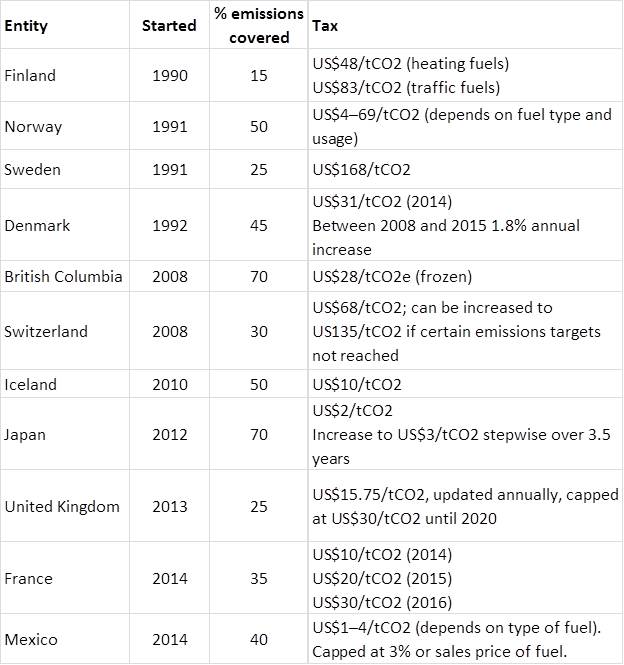Carbon Tax
Like it sounds, a carbon tax is a price on carbon emissions set by the government. It can start low and ramp up with time. With a carbon tax, emissions would be a cost to a business, and those business would attempt to minimize those costs, thereby causing a decline in emissions coincident with that cost reduction. Like allowances, or free permits, in cap and trade, tax breaks could serve the same purpose. Similarly, while offsets are typically associated with cap and trade, again tax breaks for capturing and sequestering carbon would have the same effect.
Carbon taxes were pioneered in Scandinavia with early trials in Finland (1990) Norway (1991), Sweden (1991), and Denmark (1992), and more recently in other countries as shown on the table. Data from the World Bank.

Carbon Fee and Dividend
One of the best known versions of carbon tax in the U.S., championed by the Citizens’ Climate Lobby, is called carbon fee and dividend. Although no legislation has yet been successful, the proposal has four parts:
- Put a fee on fossil fuels like coal, oil, and gas, which starts low, and grows over time.
- Return the revenue earned by the fee/tax as a dividend equally shared by all Americans, making the proposal revenue neutral.
- Assess a border adjustment to protect U.S. manufacturers and jobs, taking away any advantage for goods that come from locations that do not have a carbon price.
- Pause the EPA authority to regulate the CO2 and equivalent emissions covered by the fee for the first 10 years, The policy would be adjusted if emission targets are not met.
Carbon Tax in Denmark
The Danish carbon tax was introduced gradually as part of a larger program including energy and sulfur taxes and subsidies for green investments. Denmark primary energy intensity declined by 26% from 1990 to 2010 and CO2 emissions were reduced by 25% per produced unit from 1993 to 2000. However, it is not clear to what degree this can be attributed to the carbon taxes.(World Bank data). A goal was to avoid increasing the overall tax burden, so the energy tax was lowered with introduction of the carbon tax. The tax covers consumption of natural gas, oil, coal and non-biodegradable waste used as fuel with partial exemption for sectors covered by the EU ETS. The impact on GDP and employment was evaluated as generally positive, although again, other conditions were also changing at the time.
Carbon Tax in British Columbia
The British Columbia revenue-neutral carbon tax is a key component of their Climate Action Plan to reduce GHG emissions by 33% below 2007 levels by 2020. The BC carbon tax has the following key elements:
- All carbon tax revenue is recycled through tax reductions
- The tax rate started low and increased gradually – The initial carbon tax rate was CAN$10/tCO2e, gradually
increasing by an annual rate of CAN$5/tCO2e to CAN$30/tCO2e (US$28) in 2012 where it is frozen. - Low-income individuals and families are protected
- The tax has the broadest possible base
- The tax will be integrated with other measures – The plan is to integrate carbon tax with complementary measures such as a cap and trade as the system is developed.
Thus far, the tax looks successful; emissions were reduced without hurting the economy. From 2008 to 2011, BC had reduced those Greenhouse Gases (GHG) subject to the tax by 10%. From 2009 to 2013, BC’s real GDP growth was on a par with Canada. According to the World Bank report, the BC budget has become increasingly reliant on the carbon tax revenues. As expected, the tax has been debated and tested in elections, but has thus far survived scrutiny.
See World Bank Report, May 2014, pp. 84-87 for more detail on the Danish and British Columbia carbon taxes.
